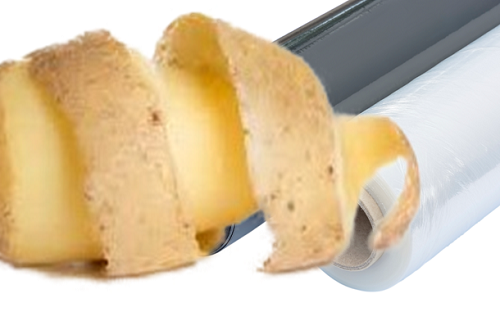Indian scientists make biopolymer films from potato peel and fruit pomace, which can be used to store perishable food products, such as bread.
Potato peel and fruit pomace are generally thrown away as waste. But scientists at Tezpur University in the north-eastern Assam state have turned into packaging material for food products like bread.
The biopolymer films made from potato peels and fruit pomace waste are 0.3 millimeters thin and can withstand temperatures as high as 200 degree Celsius. They have good breakage strength and elongation capacity. Moreover they are biodegradable and can be used to store perishable foods such as bread.
Potato peel and sweet lime pulp, collected locally, were used for the study. The peel was washed, dried and then grounded to make a fine powder. After chemical treatment, it was poured into glass petri plates and cast into thin biopolymer films. It was cross-linked using calcium chloride to increase strength. During the process, it was also treated with ultrasound waves for 60 minutes that helped to break down the polymer particles small enough to form a thin film. After this process, scientists obtained amber-colored biopolymer films.
Clove oil was added to the films to impart anti-bacterial properties so that they can be used for storing perishable food items such as bread. To test the ability of the biofilm to preserve food, bread was either kept open or wrapped in polyethylene sheet or in the new biopolymer film for 5 days. Biopolymer film prevented weight loss and microbial growth.
“The film was successful in lowering the weight loss, reducing the hardness and inhibiting surface microbial load from bread sample”, said the scientists who developed the new biofilm. The research results have been published in journal Ultrasonics Sonochemistry.
“Although many such biofilms are available, they have to be made commercially viable”, said Jitender Sahu, professor of food processing technologies at Indian Institute of Delhi, who was not connected with the study.
Biopolymer films have the potential to replace plastics as they are renewable and biodegradable but their commercial success is limited as they are costly, prevent moisture poorly, and have low strength. However, if agricultural waste is used to make biopolymer films, the costs can be cut down significantly.
India is the third largest producer of potato in the world after China and Russia. The amount of waste is estimated to be around 12–20% of the total produce. Potato peel contains sufficient quantities of starch, cellulose, hemicellulose and fermentable sugars, which are desirable for making biopolymer films. Similarly, sweet lime peel is a source of flavonoids, pectin, and essential oils that have antimicrobial, antioxidant, anti-inflammatory, and anxiolytic properties, which is of use in food industry.


